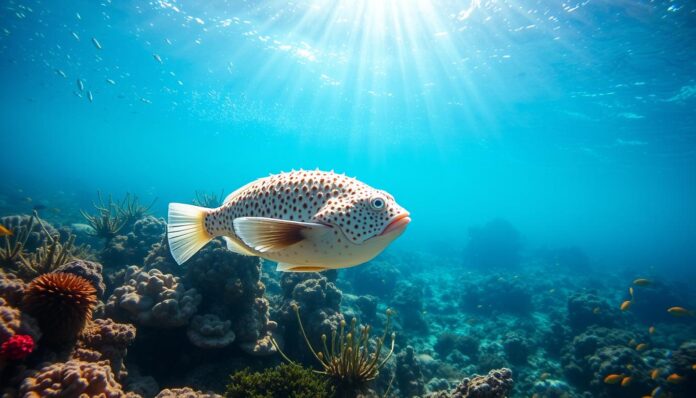Dive into a world where marine wildlife transforms before your eyes! Did you know that pufferfish can inflate to more than double their original body size in seconds? These remarkable creatures represent one of the most fascinating underwater exploration experiences for scuba diving enthusiasts.
Scuba diving with pufferfish offers an extraordinary glimpse into the ocean’s most unique marine inhabitants. The Tetraodontiformes order boasts over 360 species across 10 families, making these living balloons a diverse and captivating group of marine wildlife.
From shallow coral reefs to depths of 200 meters, pufferfish live in many marine environments. Their ability to change from small, unassuming fish to round, spiky defenders makes them one of the most intriguing creatures you’ll encounter during underwater exploration.
Key Takeaways – Diving with Pufferfish
- Pufferfish can dramatically change their body size as a defense mechanism
- Over 360 species exist within the Tetraodontiformes order
- These marine creatures inhabit diverse underwater environments
- Scuba diving offers unique opportunities to observe pufferfish behavior
- Understanding marine wildlife enhances underwater exploration experiences
Introduction to Pufferfish in the Ocean
Dive into the fascinating world of pufferfish, marine marvels that captivate scuba divers and marine enthusiasts worldwide. These unique creatures are more than just inflatable fish – they’re complex marine organisms with remarkable survival strategies.
What Are Pufferfish?
Pufferfish belong to the order Tetradontiformes, with over 360 species across 10 families. Pufferfish encounters show these amazing creatures in both saltwater and freshwater. About 120 species live in tropical and subtropical waters.
- Size range: 2 cm to 60 cm
- Habitat: Oceans worldwide, with a focus on the Indo-Pacific region
- Lifespan: 5 to 10 years in the wild
Unique Features of Pufferfish
Pufferfish have amazing defense mechanisms. They can inflate to more than twice their size when threatened. Their most impressive feature is the potent neurotoxin tetrodotoxin, making them one of the most poisonous marine creatures.
“Pufferfish are nature’s living balloons, armed with a chemical defense more powerful than most predators can handle.”
Marine conservation efforts are key to protecting these incredible creatures. Overfishing, habitat destruction, and pollution threaten pufferfish populations. This shows the need for sustainable marine practices.
- Can inflate multiple times throughout life
- Toxin is 1,200 times more potent than cyanide
- Sharks are the only known predators immune to their toxin
Learning about pufferfish enriches our understanding of marine biodiversity. It also highlights the delicate balance of ocean ecosystems. Their survival shows the incredible adaptations of marine life.
The Habitat of Pufferfish
Dive into the fascinating world of pufferfish and explore their remarkable marine environments. These unique creatures have mastered the art of survival across diverse underwater landscapes. Tropical destinations are a paradise for scuba diving enthusiasts.
Preferred Environments
Pufferfish thrive in a remarkable range of marine ecosystems. Their preferred habitats include:
- Vibrant coral reefs
- Rocky underwater terrain
- Mangrove forest areas
- Underwater grasslands
- Tropical and subtropical waters
“The ocean is their playground, and every environment tells a unique story of adaptation.” – Marine Biologist
Key Locations for Scuba Diving
For those seeking diving certification and pufferfish encounters, several regions stand out as prime destinations:
| Region | Notable Characteristics | Pufferfish Diversity |
|---|---|---|
| Indo-Pacific | Rich marine biodiversity | High concentration of species |
| Caribbean | Clear warm waters | Multiple pufferfish varieties |
| Indonesian Archipelago | Extensive coral reef systems | Unique subspecies presence |
With over 120 known species worldwide, pufferfish demonstrate remarkable adaptability. Their ability to inhabit diverse marine environments makes them fascinating subjects for underwater exploration and scientific research.
Pro tip for aspiring divers: Obtain proper diving certification before venturing into these complex marine ecosystems to ensure safe and responsible underwater experiences.
The Behavior of Pufferfish
Diving into the world of marine wildlife shows us the amazing pufferfish. These fish are fascinating and loved by eco-tourism fans. They have unique survival skills that make them special in the ocean.
Social Interactions of Pufferfish
Pufferfish usually swim alone, exploring their home in the sea. They sometimes come together in small groups during breeding times, mainly with young fish. Their way of living shows how they adapt to their surroundings.
- Typically swim alone in marine environments
- Gather in small groups during breeding periods
- Communicate through subtle body language
Defensive Mechanisms
The most amazing thing about pufferfish is how they defend themselves. When they feel threatened, they can change their body shape dramatically. This is a key way they survive.
| Defensive Strategy | Details |
|---|---|
| Body Inflation | Can expand to 3 times original size in 15 seconds |
| Toxin Production | Contains lethal neurotoxin tetrodotoxin in organs and skin |
| Immobility Period | Takes 5.6 hours to return to normal metabolic state |
“Nature’s ultimate survival artist” – Marine Biologist
Learning about these amazing defense skills helps us understand marine wildlife better. It also teaches us to respect these incredible creatures when we see them in the sea.
Preparing for Your Scuba Diving Adventure
Diving with pufferfish needs careful planning and a focus on safety. Whether you’re getting your diving certification or exploring the sea, knowing your gear and safety rules is key. It makes for a memorable underwater journey.
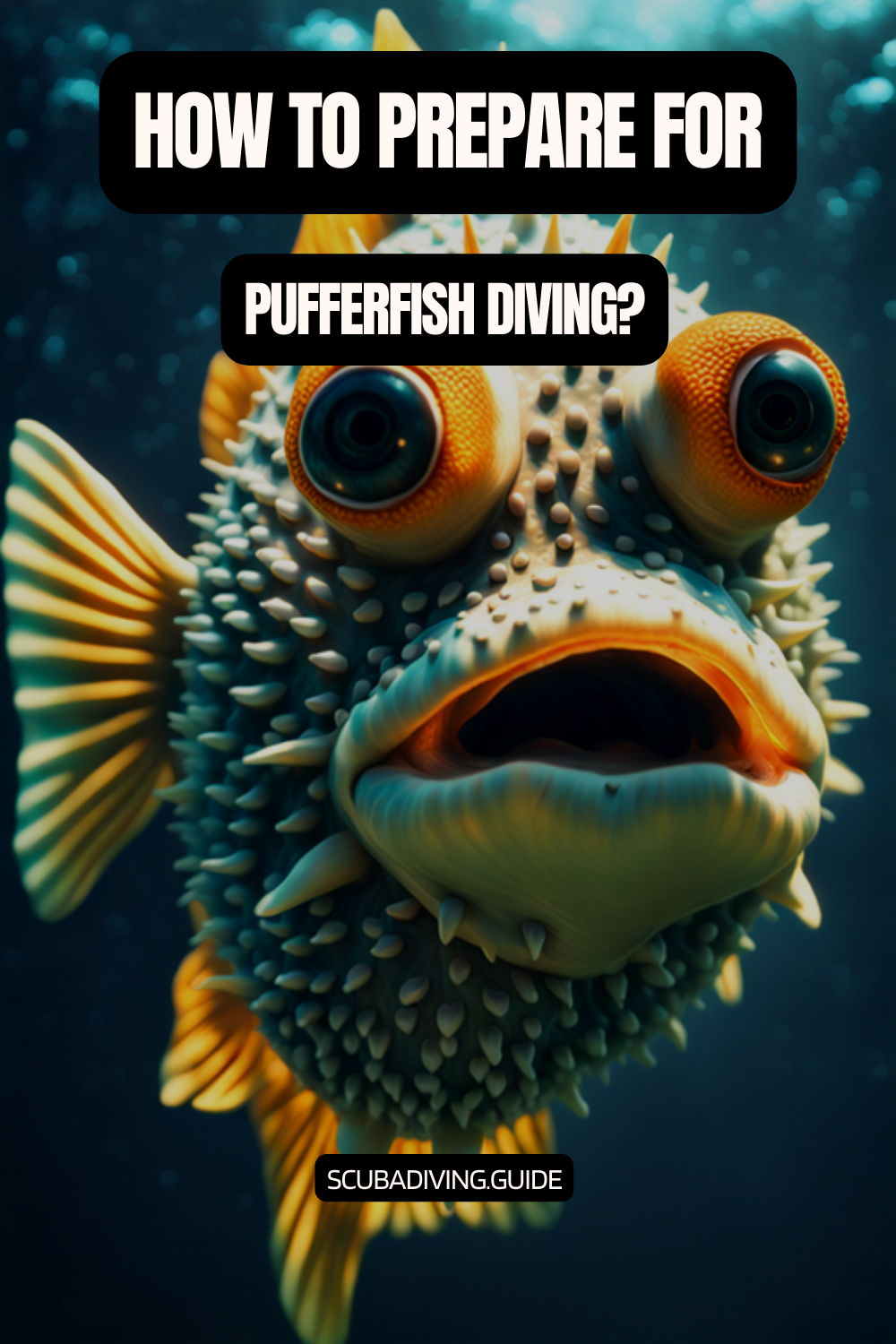
Essential Gear for Scuba Diving
Choosing the right gear is vital for a great dive. Here’s what every diver should have:
- Wetsuit with proper thermal protection
- Mask with clear, tempered glass
- Fins for efficient underwater movement
- Buoyancy control device (BCD)
- Dive computer for tracking depth and time
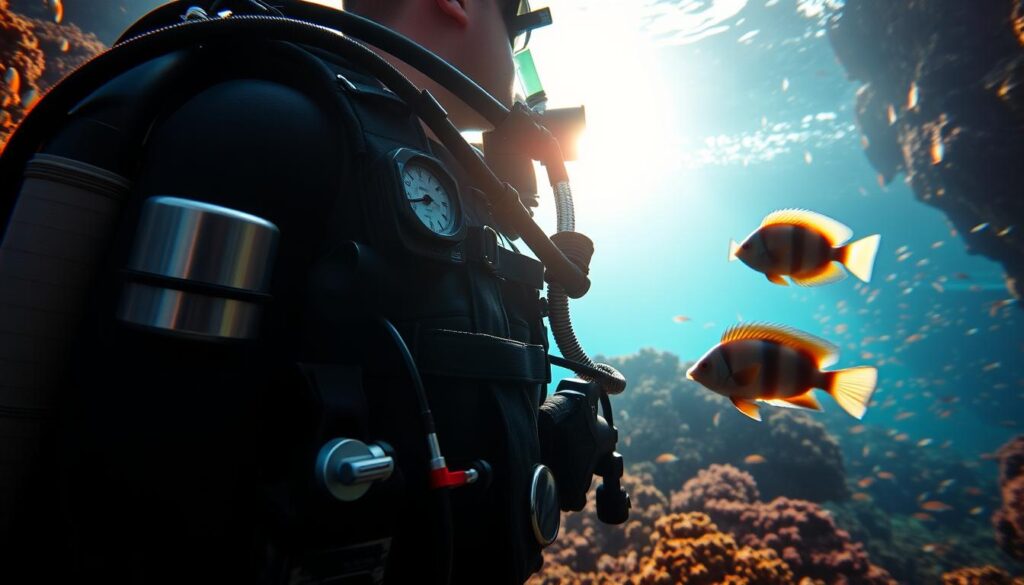
Safety Tips When Diving
Safety in diving is more than just the right gear. Knowing the sea and its dangers is also important for a safe dive.
| Safety Aspect | Recommended Practice |
|---|---|
| Oxygen Management | Monitor tank pressure and maintain reserve air |
| Buddy System | Always dive with a certified partner |
| Physical Fitness | Maintain good health and swimming capabilities |
| Emergency Protocols | Know rescue and communication techniques |
“Preparation is the key to a safe and enjoyable diving experience.” – Marine Exploration Institute
Getting your diving certification is important. Learning these safety steps can prevent underwater dangers. It lets you enjoy marine life, like pufferfish, more.
Best Times to Dive with Pufferfish
Timing is key when exploring tropical waters where pufferfish live. Knowing when to dive can make your experience better. It’s all about the seasons and the weather.
Seasonal Patterns in Pufferfish Activity
Pufferfish behave differently at different times of the year. With 120 species in warm waters, their activity changes with the seasons:
- Winter months: Reduced activity in tropical destinations
- Spring and summer: Peak breeding and feeding periods
- Night hours: Most active feeding time
Weather Considerations for Underwater Exploration
Good weather is essential for spotting pufferfish:
- Water temperature stability
- Clear visibility conditions
- Minimal ocean currents
“The magic of diving happens when preparation meets opportunity” – Marine Exploration Expert
Choose tropical spots with steady marine life. The Indian, Pacific, and Atlantic oceans are great for seeing pufferfish when they’re most active.
Popular Diving Destinations
Tropical destinations are perfect for eco-tourism divers. They offer amazing chances to see unique marine life. Pufferfish lovers can dive into breathtaking underwater worlds and find these creatures in their homes.
Diving fans have many amazing places to go for their pufferfish adventure:
Top Locations for Pufferfish Sightings
Asia:
Indonesia – With its vast archipelago, Indonesia offers an abundance of dive sites to encounter pufferfish. Destinations such as Bali, Komodo National Park, and the Raja Ampat Islands are known for their rich marine biodiversity and pufferfish populations.
Maldives – The Maldives boasts stunning coral reefs and clear blue waters that provide the perfect backdrop for diving. Here, you can dive alongside pufferfish while exploring the vibrant reefs and encountering other marine species like turtles, manta rays, and reef sharks.
Egypt – The Red Sea is a renowned diving destination, and Egypt offers excellent opportunities to dive with pufferfish. Places like Sharm El Sheikh, Dahab, and Hurghada are known for their diverse marine life, including pufferfish, vibrant coral reefs, and mesmerizing underwater landscapes.
Mozambique – The warm waters of Mozambique are home to an array of marine life, including pufferfish. Diving in destinations like Tofo Beach and the Bazaruto Archipelago allows you to explore pristine coral reefs and encounter these fascinating creatures.
Caribbean:
Bonaire – Located in the Dutch Caribbean, Bonaire is a diver’s paradise known for its exceptional marine life. The island offers easy shore diving opportunities, where you can spot pufferfish among colorful reefs and explore the famed Bonaire National Marine Park.
Cayman Islands – The Cayman Islands offer world-class diving experiences with diverse marine ecosystems. Grand Cayman, Little Cayman, and Cayman Brac are known for their healthy coral reefs, where you can encounter pufferfish along with other Caribbean reef fish.
Belize – With the Belize Barrier Reef, a UNESCO World Heritage Site, Belize is a top destination for diving enthusiasts. The barrier reef is teeming with marine life, including pufferfish, and provides a wealth of dive sites to explore.
Costa Rica – The Pacific and Caribbean coasts of Costa Rica offer exciting dive opportunities. Destinations like Cocos Island and Cano Island are known for their incredible biodiversity and the chance to encounter pufferfish alongside sharks, rays, and large schools of fish.
Canary Islands, Spain – The Canary Islands, off the coast of Africa, provide exceptional diving opportunities in the Atlantic Ocean. Destinations such as Lanzarote and Tenerife offer volcanic landscapes, clear waters, and the chance to dive with pufferfish and other unique species.
Greece – The Greek islands, including Crete, Rhodes, and Zakynthos, offer picturesque diving experiences in the Mediterranean Sea. While exploring the crystal-clear waters, you can encounter pufferfish, explore underwater caves, and discover ancient ruins submerged beneath the surface.
Australia – The Great Barrier Reef, located off the coast of Queensland, is a world-renowned destination for diving. Here, you can encounter various species of pufferfish along with an incredible array of marine life, including colorful corals, reef sharks, and sea turtles.
Palau – Palau, a Pacific island nation, is famous for its pristine reefs and crystal-clear waters. Diving in destinations like the Rock Islands and Blue Corner Wall allows you to witness the beauty of pufferfish alongside abundant marine biodiversity, including reef sharks, manta rays, and anemonefish.
Mexico – Mexico offers diverse diving experiences in both the Pacific Ocean and the Caribbean Sea. Cozumel, Playa del Carmen, and the Riviera Maya are known for their impressive coral reefs and encounters with pufferfish, sea turtles, and nurse sharks.
Florida, USA – Florida’s warm waters are home to a variety of marine life, including pufferfish. The Florida Keys, with its iconic coral reef system, provide excellent diving opportunities to encounter these captivating creatures.
Galapagos Islands, Ecuador – The Galapagos Islands are a UNESCO World Heritage Site known for their unique wildlife, both on land and underwater. Diving in this archipelago offers the chance to encounter pufferfish alongside sea lions, marine iguanas, and schooling hammerhead sharks.
Fernando de Noronha, Brazil – Located off the northeastern coast of Brazil, Fernando de Noronha is a marine protected area teeming with marine life. Diving here allows you to observe pufferfish, as well as sea turtles, dolphins, and colorful reef fish.
These destinations offer exceptional opportunities to dive with pufferfish and explore the wonders of the underwater world. Each region has its unique charm and biodiversity, ensuring unforgettable encounters with these enchanting creatures. Remember to dive responsibly, respect the marine environment, and adhere to local regulations to preserve these remarkable dive sites for future generations.
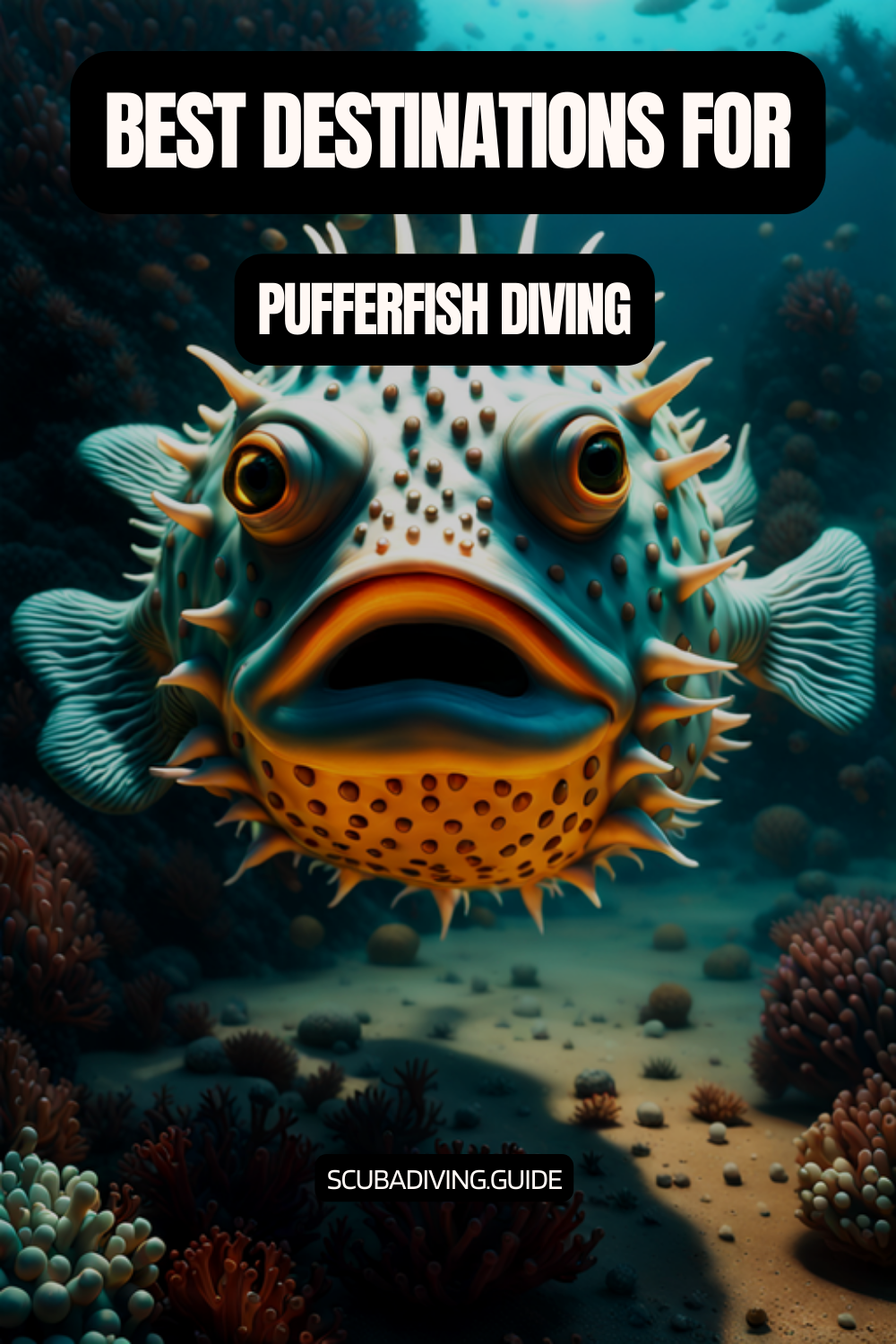
Diving Operators to Consider
Choosing a diving operator for your pufferfish trip is key. Look for those who care about the ocean. They should:
- Show they care about marine conservation
- Give detailed safety briefings
- Have guides who know the local sea well
“The ocean is a magical world waiting to be explored, one pufferfish at a time.” – Marine Exploration Society
Whether you’re new to diving or have lots of experience, these tropical spots offer unforgettable dives. You’ll see pufferfish in their natural home.
Understanding Pufferfish Diet
Diving into the world of pufferfish shows us a fascinating underwater culinary scene. These unique creatures have developed amazing eating habits. It makes exploring the ocean truly captivating.
What Do Pufferfish Eat?
Pufferfish have an impressive diet that shows their adaptability in the ocean. They mainly eat a wide variety of ocean foods:
- Hard-shelled mollusks
- Sea urchins
- Hermit crabs
- Algae
- Invertebrates like worms and snails
“A pufferfish’s diet is a testament to its incredible survival skills in the underwater world.”
Impact of Diet on Scuba Diving
Knowing what pufferfish eat makes diving better. Their strong teeth help them eat hard-shelled food. This affects where they live and how they act. Scuba divers can guess where to find pufferfish.
There are over 120 species of pufferfish around the world. Each has its own special way of eating. They can be found in shallow reefs or deeper waters. Every dive could be a chance to discover new foods.
Their diet shows the complex balance of marine life. It gives divers a peek into the clever ways these creatures survive.
Respecting Marine Life
Scuba diving lets us see the underwater world up close. But, we must use this chance wisely. We need to protect marine life and keep creatures like pufferfish safe.
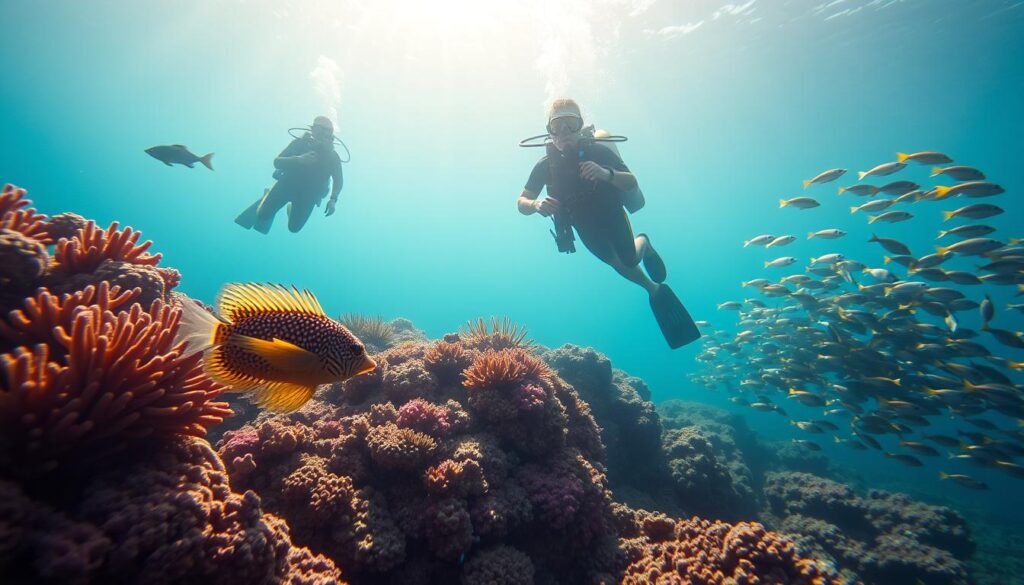
Our history with the sea has changed a lot. In the past, divers didn’t think much about the sea’s health. But, thanks to awareness efforts from the 1990s, we now see the sea’s importance.
Ethical Diving Guidelines
Good diving means we don’t harm the sea. Here are some important rules:
- Keep a safe distance from sea creatures
- Don’t touch or disturb marine life
- Control your buoyancy to avoid accidents
- Never feed or attract sea creatures
Conservation Challenges
The sea faces big threats from us. Even small actions can hurt the delicate underwater world.
| Human Action | Potential Ecological Impact |
|---|---|
| Touching Marine Life | Removes protective layers, increases infection risk |
| Artificial Feeding | Disrupts natural migration and feeding patterns |
| Coral Contact | Can kill coral structures that take years to form |
“Leave only bubbles, take only photos” – The fundamental principle of responsible marine conservation.
By diving responsibly, we protect the sea and its wonders. Marine conservation is more than a choice; it’s a promise to our planet.
Encountering Pufferfish Underwater
Exploring the underwater world is magical, and pufferfish encounters are among the most exciting. These creatures add a unique touch to the sea with their looks and behaviors.
Before diving into pufferfish encounters, it’s good to know about these marine wonders. They have amazing defense tricks that make them stand out underwater.
What to Expect During Your Dive
On your dive, you might see pufferfish in different ways:
- Relaxed and slowly moving through coral reefs
- Changing colors when they feel scared
- Inflating their bodies for defense
- Showing off cool patterns and textures
Tips for a Memorable Experience
To have a great time with pufferfish, follow these tips:
- Keep a safe distance
- Move slowly and carefully
- Be quiet while diving
- Avoid sudden actions
“Patience and calm are your best tools when exploring the underwater world of pufferfish.”
Studies show pufferfish are sensitive to their surroundings. Watching them carefully without disturbing them keeps both divers and marine life safe.
Photography Tips for Scuba Divers
Exploring underwater is a special chance for photographers to see the amazing marine world. Taking pictures of pufferfish needs special skills. You must know how to use your camera and understand marine life.
Getting great underwater shots takes skill and patience. Studies show that 80% of new underwater photographers face challenges like mastering buoyancy. This skill is key to taking good photos.
Capturing Pufferfish in Their Natural Habitat
Here are some important tips for taking pufferfish photos:
- Stay within 1 meter of your subject for clear images
- Use natural light whenever you can (most photographers prefer it)
- Know how pufferfish behave to catch the best shots
- Move slowly to not scare the marine life
Best Techniques for Underwater Photography
Experts suggest these advanced techniques:
- Manual Exposure Settings: Set your camera before you get close to your subject
- Use macro lenses for more detail (they give 45% better precision)
- Adjust white balance for accurate colors
- Learn post-processing techniques
“Get close, Get down and Shoot up” – A principle for creating dramatic underwater images
With practice and knowledge, underwater photography can become an art. It lets photographers show the marine world in a new, intimate way.
Learning from Your Dive Experience
Diving with pufferfish is more than just an underwater adventure. It’s a chance to grow as a marine enthusiast and learn about ocean ecosystems. Reflecting on your dives can turn a simple experience into a deep learning journey.
Professional divers know that every dive offers unique insights. To get the most out of your experience, try these tips for improving your diving skills and practices:
- Maintain a detailed dive log with observations
- Photograph marine life respectfully
- Share experiences with diving communities
- Participate in marine conservation programs
Reflecting on Marine Encounters
Every pufferfish encounter has a story to tell. Documenting your observations helps with scientific research and personal growth. By noting behaviors, habitats, and unique interactions, you become a citizen scientist.
“The ocean is a classroom, and every dive is a lesson.” – Marine Biologist
Connecting with Other Divers
Connecting with other divers can greatly improve your underwater knowledge. Join local dive clubs, online forums, and conservation groups to share and learn from others.
| Networking Platform | Benefits |
|---|---|
| Local Dive Clubs | In-person knowledge sharing |
| Online Forums | Global community interaction |
| Conservation Organizations | Direct marine research involvement |
Remember, diving responsibly means always learning and respecting marine environments. Your passion can inspire others and help protect our oceans.
Common Marine Species Found Alongside Pufferfish
When diving with pufferfish, you’ll have the opportunity to encounter a wide variety of marine species that share their habitats. These diverse underwater ecosystems are home to an array of fascinating creatures, each contributing to the vibrant tapestry of marine life. Let’s explore some of the common marine species that you may encounter alongside pufferfish during your dives.
- Reef Fish: Pufferfish often inhabit coral reef ecosystems, where they coexist with a multitude of colorful reef fish. You may encounter species such as clownfish, angelfish, butterflyfish, parrotfish, and wrasses. These vibrant fish darting among the corals provide a stunning backdrop to your pufferfish encounters.
- Sea Turtles: Another enchanting creature often spotted in the vicinity of pufferfish is the sea turtle. These graceful reptiles are known to frequent coral reefs and seagrass beds, where they find food and shelter. Observing sea turtles gliding through the water alongside pufferfish adds to the magical experience of diving and showcases the rich biodiversity of the marine environment.
- Moray Eels: Moray eels are common inhabitants of reef environments and can often be found cohabiting with pufferfish. These elongated and often elusive creatures can be spotted lurking in crevices or coral heads. Their presence adds an element of intrigue to your dives, as you observe their snakelike movements and intricate patterns.
- Stingrays: Stingrays are often encountered in sandy or rocky areas near coral reefs. These flat-bodied creatures gracefully glide across the ocean floor, occasionally stirring up sand in search of food. Swimming alongside pufferfish, stingrays provide a glimpse into the elegance and grace of marine life.
- Seahorses: In seagrass meadows and coral reef environments, seahorses can be found clinging to seagrass blades or coral branches. These delicate and fascinating creatures, known for their unique appearance and captivating mating rituals, often coexist with pufferfish. Spotting a seahorse in its natural habitat is a truly magical experience that complements encounters with pufferfish.
- Lionfish: Lionfish, with their flamboyant appearance and flowing fins, are both beautiful and potentially invasive species. While their presence may vary depending on the region, encountering lionfish alongside pufferfish is not uncommon. Observing the contrasting behaviors and characteristics of these two species highlights the ecological diversity found underwater.
- Triggerfish: Triggerfish, known for their distinctive shape and bold colors, are often found near coral reefs and rocky areas. These curious and territorial fish can be seen patrolling their territories alongside pufferfish. Keep an eye out for their interesting behaviors and striking patterns as they interact with their environment.
- Crustaceans: Diving with pufferfish also provides opportunities to observe various crustaceans, such as crabs and shrimps. These small but fascinating creatures are adept at camouflaging themselves within their surroundings, making them a delight to discover while exploring the reefs.
- Invertebrates: Coral reefs are home to a plethora of invertebrates, including colorful nudibranchs, sea anemones, and starfish. These intricate and diverse creatures contribute to the overall richness of the marine ecosystem. Taking the time to observe their vibrant colors and unique forms enhances the experience of diving with pufferfish.
- Schooling Fish: Large schools of fish, such as fusiliers, surgeonfish, and jacks, often pass by reef environments. The synchronized movements and shimmering reflections of these shoals provide a breathtaking spectacle. Interactions between pufferfish and these schools of fish create dynamic scenes that showcase the interconnectedness of marine life.
Encountering these common marine species alongside pufferfish highlights the interconnectedness and biodiversity of underwater ecosystems. Each species plays a vital role in maintaining the delicate balance of these habitats. By appreciating the diversity of marine life, you gain a deeper understanding of the complex web of interactions that make these environments thrive.
As you dive alongside pufferfish, keep your eyes open for these remarkable creatures and relish in the opportunity to witness the harmonious coexistence of various marine species. It is through these encounters that we come to appreciate the wonders of the underwater world and the need for their protection and conservation.
Conclusion: The Joy of Diving with Pufferfish
Scuba diving with pufferfish opens a window to the marine world’s amazing diversity. These unique creatures are just one of the many fascinating experiences for underwater explorers. They show the complexity of ocean ecosystems with their ability to inflate and their survival mechanisms.
Every dive is a chance to learn something new. Exploring places like Sharm el Sheikh, Egypt, reveals marine life that challenges our understanding. Seeing pufferfish up close makes us appreciate the underwater world and its delicate balance.
Final Thoughts on Underwater Diversity
Marine conservation starts with a personal connection. By diving with pufferfish, you help understand and protect our planet’s ecosystems. Their anatomy, from elastic skin to precise muscle movements, shows nature’s incredible design. It highlights the need to preserve these environments.
Encouragement to Explore Aquatic Life
Your underwater journey doesn’t stop here. Keep exploring, learning, and fighting for marine ecosystems. Every dive is a chance to discover, wonder, and protect the world beneath the waves. Embrace the adventure, respect marine life, and inspire others to care for our planet’s treasures.
FAQ – Diving with Pufferfish
Are pufferfish dangerous to divers?
Pufferfish have a toxin called tetrodotoxin, but they usually don’t attack divers. It’s important to keep a safe distance and not touch them. If they feel threatened, they inflate to defend themselves. So, it’s best to watch them calmly and safely.
What diving certification do I need to dive with pufferfish?
You usually need an Open Water Diver certification to dive where pufferfish are found. For more challenging dives, an Advanced Open Water certification might be needed. Always check the local diving conditions and talk to dive operators about what you need.
Where are the best destinations to see pufferfish?
Great places to see pufferfish include the Great Barrier Reef in Australia and the Caribbean. Also, the Maldives, Philippines, and Indonesia are good spots. These places have the right environment for pufferfish to thrive, making them great for underwater exploration.
How do pufferfish defend themselves?
Pufferfish defend themselves by inflating and being toxic. They can quickly fill with water or air, becoming a big, spiky ball. Their body also has tetrodotoxin, making them unpalatable and dangerous to predators.
What equipment do I need for pufferfish diving?
You’ll need a wetsuit, mask, fins, camera, dive computer, and BCD. For photos, a wide-angle or macro lens is best. Make sure your gear is in good shape and you know how to use it before diving.
When is the best time to dive with pufferfish?
Pufferfish are active all year in tropical areas. The best time varies by location. Dry seasons with calm waters and clear visibility are usually best. Check the local marine ecosystem and talk to dive operators for the best times.
Are pufferfish endangered?
Not all pufferfish are endangered, but many are threatened. Threats include habitat loss, overfishing, and climate change. By diving responsibly and supporting conservation, we can help protect these creatures.
Can I touch a pufferfish during a dive?
No, you should never touch a pufferfish. Their toxin can harm you, and touching them stresses the fish. It’s important to observe them from a distance and respect their space.
How long do pufferfish live?
Pufferfish lifespans vary, but most live 5 to 10 years. Their diet, habitat, and environment affect their lifespan. In protected areas, they may live longer with better conditions.
What do pufferfish eat?
Pufferfish eat coral, algae, mollusks, crustaceans, and small invertebrates. Different species have different diets based on their habitat. Knowing what they eat helps divers find them.
